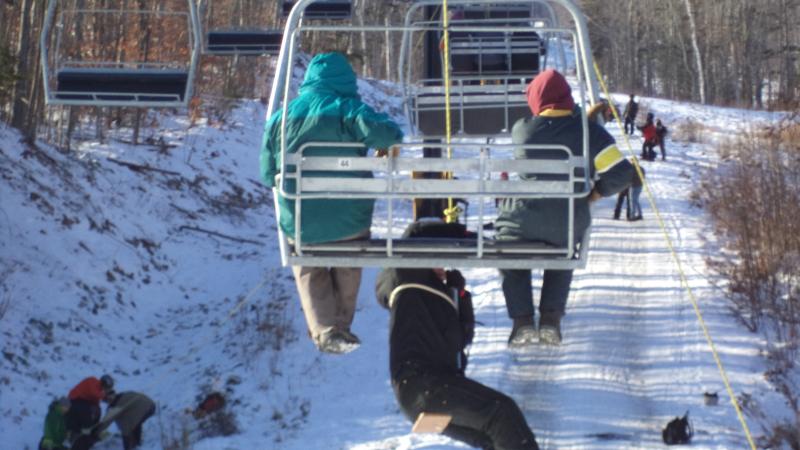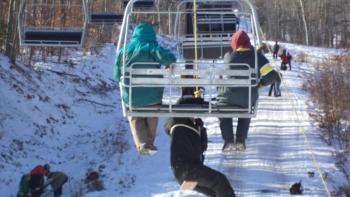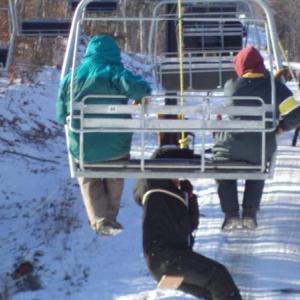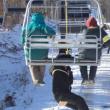Ragged Mountain Ski Patrol readies for season at Camden Snow Bowl with lift evacuation drills
 A victim of the Camden Snow Bowl Ski Patrol team is lowered to the ground. (Photo by Sarah Thompson)
A victim of the Camden Snow Bowl Ski Patrol team is lowered to the ground. (Photo by Sarah Thompson)
 A victim of the Camden Snow Bowl Ski Patrol team is lowered to the ground. (Photo by Sarah Thompson)
A victim of the Camden Snow Bowl Ski Patrol team is lowered to the ground. (Photo by Sarah Thompson)
CAMDEN – On belay! The Camden Snow Bowl’s triple chairlift came to a halt during a three-hour training session Sunday, Dec. 17. Ski patrollers hustled to the scene, fastened their carabeeners, and began lobbing ropes into the air and over cables.
Ahead of the Friday, Dec. 22 season-opening day at the mountain, patrollers were practicing rock-climbing skills used to evacuate skiers marooned on chairlifts that, for one reason or another, have grounded to a extended halt.
Through the years, other ski facilities have been forced to evacuate skiers from lifts, and the Snow Bowl is taking no chances. Periodically through the year, Snow Bowl patrollers practice the mountain’s own chair evacuation drill, should such an incident occur in Camden.
One hundred and 61 seats, 80 of which can be occupied at any given time. Should the triple chairlift at Camden Snow Bowl require evacuation, ski patrol organizers can already envision the scenario and are trained to respond.
Putting it mildly, people will be everywhere, according to seasoned Ski Patroller (and Camden firefighter) Galen Todd, speaking to approximately 40 volunteers who had gathered first thing in morning at the lodge for a pre-drill session.
And those people won’t be just around the chairlift, Todd said.
The double chairlift will be emptied and halted to prevent more skiers from returning to the top of the mountain, and the parking lot will fill quickly with responding aid, as well as the media and the concerned public.
“It’s going to be pretty chaotic down here as well as being chaotic up there,” he said.
In the event the chairlift stops for an extended period of time, mutual aid would arrive, primarily from Camden, with its belay-trained firefighters. North East Mobile Health Services would also get to the scene, followed by other Snow Bowl employees and volunteers, and possibly firefighters from Rockport, Lincolnville, and Hope.
With an estimated emergency offloading time for each chair at 10 minutes — and if every chair were filled with skiers — the entire operation could take approximately 2.5 hours.
Attendance booklets have been created for documentation of each and every person on a chair, along with brief assessments of each one’s physical, mental, and medical capabilities. And yes, a 15-year-old in a T-shirt constitutes a medical priority when winter temperatures dip.
Snow Bowl Ski Patrol Director Duncan Matlack, who started with the mountain in 2005, has yet to experience a chairlift evacuation here, but he knocked on wood, anyway.
The patrollers
The 2017/2018 patrol roster includes 43 members, most of whom are volunteers. They’ve all taken the 100-hour training course engineered by the National Ski Patrol, which governs Camden’s patrollers. Following testing, members are credentialed at slightly below Emergency Medical Technicians. The Outdoor Emergency Care program, better known as OEC, is a training program that is tailored to the nonurban rescuer. The program is considered the standard of training for emergency care in the outdoor environment and is recognized by resorts and recreational facilities in all 50 states.
However, the Snow Bowl’s patrollers bring far more to the slope than just gauze, slings and toboggans for transporting the injured down the mountain.
“The level of experience we have here is phenomenal,” Matlack said.
People who’ve gravitated to the job include doctors, EMTs, an emergency room technician, members of the mountain rescue team, local rescue teams, avid rock climbers, patrollers from larger ski resorts, and others who simply know Ragged Mountain, the snow, and the community.
Belay!
In the event of an unexpected chairlift stoppage, onsite mechanics have 15 minutes to rectify the problem before evacuation efforts begin. If the lift remains at a standstill, the people in red arrive on scene, unload their gear and set to work. Carabeeners click, knots tighten, and ropes fly over the tension cable. Attached to the ropes are reverse-facing seats for the stranded to shimmy onto, at the direction of the evacuation team leader. A looped rope goes around the waist and chest, and a slow yet brief descent follows.
Despite the varying levels of familiarity with the equipment, Sunday’s patrollers remained patient and level-headed. The day’s conditions proved ideal: Blue skies, little wind, and the acknowledgment that no actual problems existed. Although, as one patroller pointed out, once the ‘victims’ were in the air, the training turned into the real deal.
For this ‘victim,’ despite the perfect conditions, despite the rational brain, being told to push away from the safety of the chair and into the open air, triggered a millisecond of panic and slowing that push over the edge. The human body is wired to save itself. Mine was no different.
Medical intervention
“We do a lot of joking, but in this situation we’re dealing with people’s health,” Matlack said. “We don’t get called to a situation with somebody who’s happy and not hurt. If you think about that, you’re a volunteer, but you’re purposely putting yourself in a stressful situation. So it’s a very special type of person who can do this.”
Following a training session, Matlack pulled a thank-you note from his notebook. It was from a skier who had suffered major injuries last February at the Snow Bowl after falling down. The skier was thanking two patrollers, in particular. The man had been hospitalized with six broken ribs and broken clavicle, and in his note, expressed appreciation for the care he received by the two attendant patrollers.
Though grateful for the note, Kevin Davis told his peers: “It could be anybody’s name on that card. We are all trained to the exact same level. It wasn’t me and Brian. It’s the whole patrol.”
Statistically speaking, patrollers at the Snow Bowl respond to incidents, on average, about 1.5 times a day, according to Matlack. Those responses range from someone who’s fallen down and gone boom, please just look at me, to somebody who’s really hurt, he said.
“When we go to a situation, we have no idea what that is,” he said. “So we have to be prepared.”
Reach Sarah Thompson at news@penbaypilot.com
Event Date
Address
United States






















